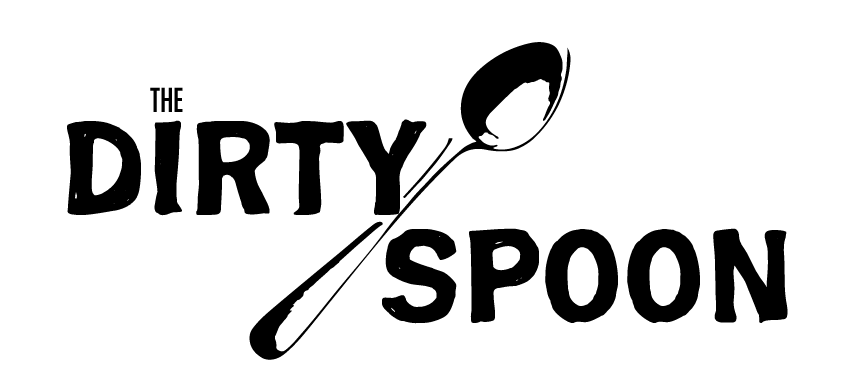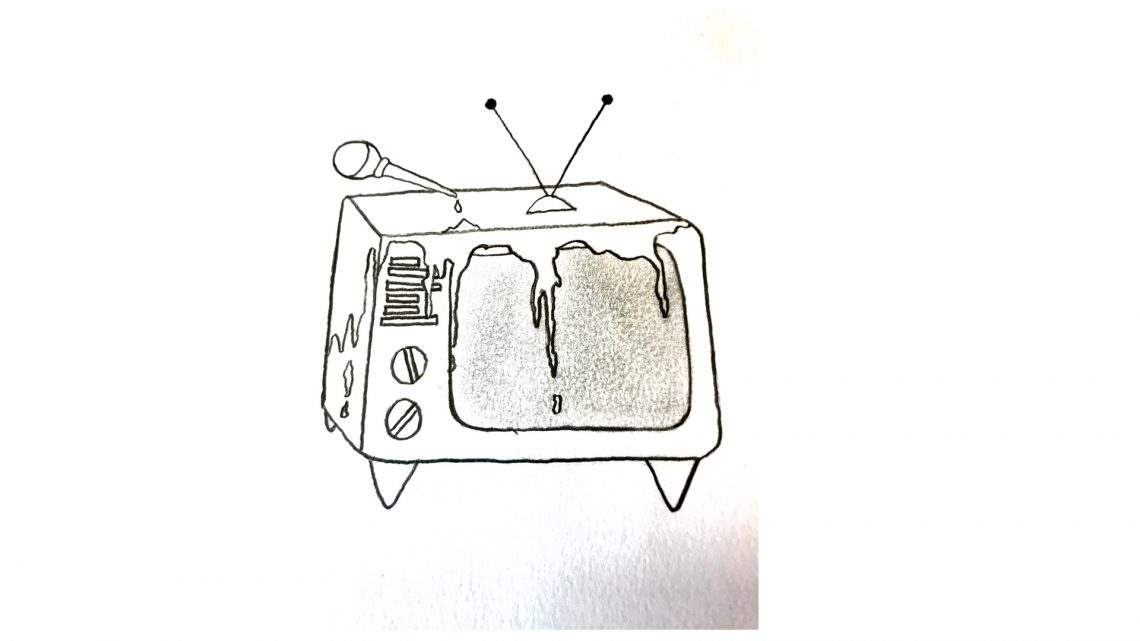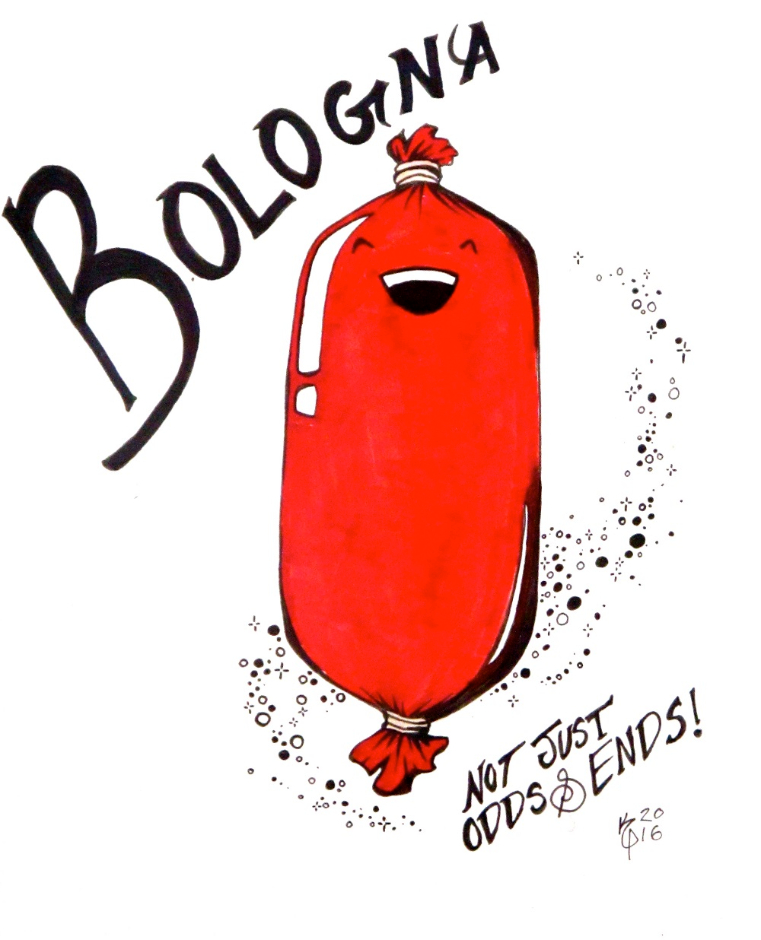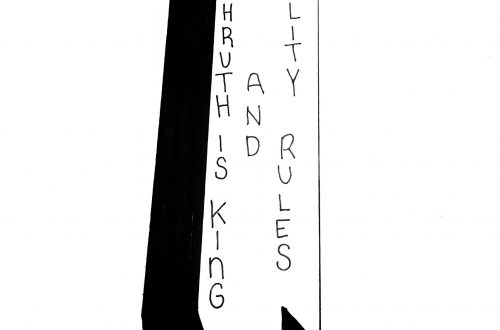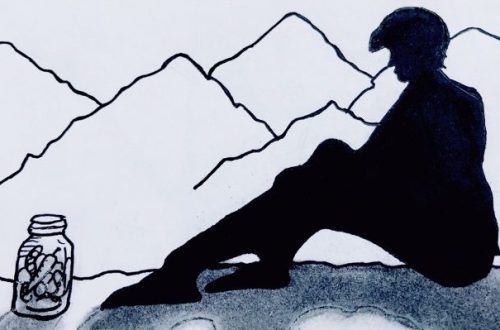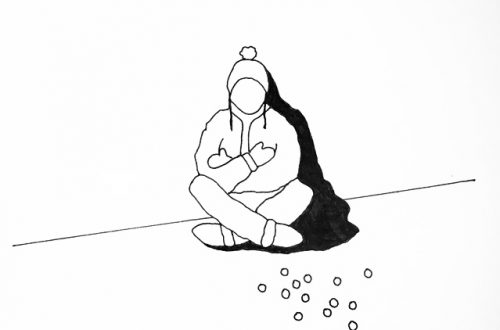by Catherine Campbell
Catherine’s essay, “Remote Cravings,” appears in The Dirty Spoon Radio Hour, episode 1, which aired May 18, 2018.
The first cooking show I ever saw was by pure accident. I noticed it, not through the ways we normally discover cooking shows at the touch of a remote or through a friend’s recommendation. I saw my first cooking show on a screen within a screen.
At the age of 10, while watching the 80s classic, The Goonies, I came to the scene where one of the young heroes, Chunk, is captured by a villainous family and tied up in a basement with the family’s well-meaning and innocent brother, Sloth. Chunk watches as Sloth is fixated on the television in front of him, oblivious to this new stranger in the basement. That’s because Sloth is watching a woman frost a chocolate cake. “Chocolate,” he says with longing. The woman on the television screen presents the cake, its layers of frosting perfectly shaped.
Of course the rest of the movie was great and magical and as a 10 year old I loved it, but that moment stuck with me. I couldn’t help but wonder: did a show like that really exist? A show where a woman could teach me how to make chocolate cake?
I couldn’t help but wonder: did a show like that really exist? A show where a woman could teach me how to make chocolate cake?
At the time, our family didn’t have cable television. So this simple question sent me on a journey to figure out who the mystery woman was in the background, and this journey would take me decades to uncover the answer: it was Julia Child, and unfortunately, at that time in 2005, she had passed away.
My second brush with cooking shows was when I stumbled upon an episode of Iron Chef. The title caught my eye, the premise drew me in. Cooks? Competing in a time limit? Using 1 ingredient that had to appear in every meal course?
That was it. I strapped in for the ride.
As I watched the chefs competing for the title on Iron Chef, I tried to follow them, but had a little difficulty. They moved so swiftly among utensils and burners, momentarily pressing the button of the blender or quickly sampling a sauce. That was the moment I realized that what I loved most about a show like this was the exact same reason why I love a novel…it’s complete fantasy.
At least for me.
I’m your typical white woman. I have privilege and access to certain foods, kitchen space, tools, and tech to help me cook. I own an ice cream maker in the color of my choice. I own two crockpots. I’ve been considering one of those Instapots, who knows?
But the one thing I lack is time. Time to prep. Time to chop. Time to watch a casserole begin to bubble in the oven. Time to grow everything I need. Time to talk and laugh with guests as they wait and watch the pans of food simmering behind me. Time to sit down at a table and savor every bite. Because that would also require time to shop. Time to visit multiple stores. Time to make the money to buy the ingredients. Time to wash the dishes and wipe down the counters.
Isn’t it easier to watch someone else cook for sixty minutes?
After discovering Iron Chef, the landscape broke open. It was like the rest of the world existed in this one place and I had been given the key to join them.
Through my screen, I can live vicariously, almost tasting the dishes from Vietnam, Austria, New Zealand. And I’m okay with that. I’d rather watch a show where a flawlessly frosted cake appears after a few minutes than a show that mimics my own reality, where dinner is often raisin bran and milk.
After discovering Iron Chef, the landscape broke open. It was like the rest of the world existed in this one place and I had been given the key to join them. Suddenly, everywhere I turned, there was a new cooking show for me. Road trips to diners. Brave souls trying headcheese or motsunabe. Famous Michelin starred chefs smiling while presenting wasabi sorbet to an intimate group of elite jetsetters.
This begged the question: what happened between the woman frosting the cake on screen and today, where we have dozens upon dozens of cooking shows? What is it, exactly, about making food that we find so compelling we keep our eyes glued to a screen? I mean, it’s food…something that disappears into our mouths, never to return with the same shape, the same color, the same taste…what is it about crafting, chopping, sauteing, baking, plating that is so alluring on our television screens?
I assumed the history of cooking shows began with Julia Child.
She is considered to be the Godmother of Food TV the way Patti Smith is the Godmother of Punk. With Julia’s serene, non-fussy way of moving about the kitchen, she broke the mold of glittery, shiny, sparkling kitchen counter life that was so prevalant in midcentury advertising. We loved and still love Julia Child because she was…well, human. With the camera still rolling, she dropped spoons, spilled ingredients, fumbled when moving a pot from a burner to pouring liquid in a dish. But she wore pearls the whole time. Julia showed women they could be themselves, make mistakes, yet still contain an innate sense of grace. Because that’s what food and food preparation is…from a simple loaf of bread and cheese to a complicated multi course meal, it’s an experience of grace, a salvation and an experience.
But she wasn’t the first TV host.
Cooking shows technically began on the radio and transitioned to television. A radio listener–if they were in France, for example–could listen to Dr. Édouard de Pomiane’s weekly program on Radio-Paris. The food scientist and author of a dozen cookbooks would take to the airwaves, telling stories of his kitchen experiences and providing recipes that were accessible to the home cook. Meanwhile, over in the U.S., a fictional Betty Crocker, voiced at one time or another by 13 different actresses, hosted the first American food broadcast. The Betty Crocker Cooking School of the Air (yes, that was the full name) started in Minnesota on one little radio station and went national in 1926. Housewives and families would tune in while Betty Crocker answered questions and gave cooking tips.
The Betty Crocker Show wasn’t just a flash in the pan trend, like many of the types of food shows we see today on say, The Food Network or Bravo. The radio broadcast lasted for 25 years, into the late 40s, when television became popular and took over. This became the time of the in-studio cooking show, where hosts would demonstrate recipes and preparation instructions. The goal during the midcentury was to bolster the everyday housewife’s confidence in her own cooking. With a little effort, she could replicate the recipe on the screen, down to the last sprig of parsley, and feed her happy family.
This was the era of instruction, where recipes were pretty paint by numbers.
Then morning variety shows adopted segments, and the rise of the cooking star began to emerge.
Soon, television networks realized the draw of cooking shows so they created entire channels dedicated to a lifestyle centered around food. And competitions emerged.
Americans spend thousands of hours each week watching cooking shows. In 2010, a Harris report revealed that 8 in every 10 adults watch food shows. At the time, TV personality Rachael Ray dominated the networks with her reliable 30-minute meals. Today, thanks to streaming services such as Netflix and web series on YouTube, we binge-watch dramas such as the Great British Baking Show and Anthony Bourdain’s Parts Unknown, clocking an average of 2-3 episodes at a time. We have friends over for viewing parties. We crowd together on the couch for Worst Cooks in America or Chopped. Our choices of shows range from family-values middle America on The Pioneer Woman to the exotic in A Cook Abroad. Women, Southerners, and reality competitions are the major themes running throughout our food TV obsession.
Even Marvel, yes the comic book company, recently launched a cooking show. “Marvel Eats The Universe” is a show featuring pop culture influencers and recipes inspired by comic book history. In episode 1, for example, they make Phoenix Hot Chicken and Egg (based on Jean Grey and her stepson Cable). I cross my fingers for maybe some Daredevil Hell’s Kitchen pizza, because I’m simple at heart.
When I watch food shows, I’m hungry…not for the food necessarily on the screen, but the time I’ll never have to discover those tastes in real life.
So which cooking stories get told, and which ones don’t?
Anyone can publish a cookbook, but a cooking show requires a personality…someone you love to watch or love to hate. Or better yet, say the producers, put an odd couple together, add ingredients and voila! You have a show for which hundreds of thousands of people will tune in, at least for one season. It’s not about the chemistry of the food, but the chemistry of the people on screen. It’s no longer about knowledge but the delivery of that knowledge. We probably won’t see Tara Jensen, my favorite local baker on TV anytime soon. Would we as a people still be satisfied, entertained, enthralled to watch Julia Child drop a spoon or take two minutes to put on oven mitts? Or would we turn to our smartphones to browse Instagram?
When I watch food shows, I’m hungry…not for the food necessarily on the screen, but the time I’ll never have to discover those tastes in real life. I tell myself I feel full after an episode, that I’m satisfied to know that particular dish exists in the world, that some other man woman or child is enjoying it to the last bite.
But I know it’s a lie.
For other viewers, maybe it’s a different craving. They are drawn to a specific ingredient. Or the cook. Or the unique environment in which the host still manages to turn food from a science into a work of art.
I don’t know where cooking shows will go next. Virtual reality looms on the horizon, and some brands are working behind the scenes, trying to figure out a way to physically deliver food to your door at the same time it appears on screen.
In the meantime, I’ll be here on the couch with my bowl of cereal, pressing the remote, flipping endlessly through all of my options to observe the next great meal just out of my reach.
Catherine Campbell is co-host of The Dirty Spoon Radio Hour, and serves as Editor-at-Large for The Dirty Spoon. Find her on Twitter: @thecatcampbell.
Artwork by Corrine Pease.
